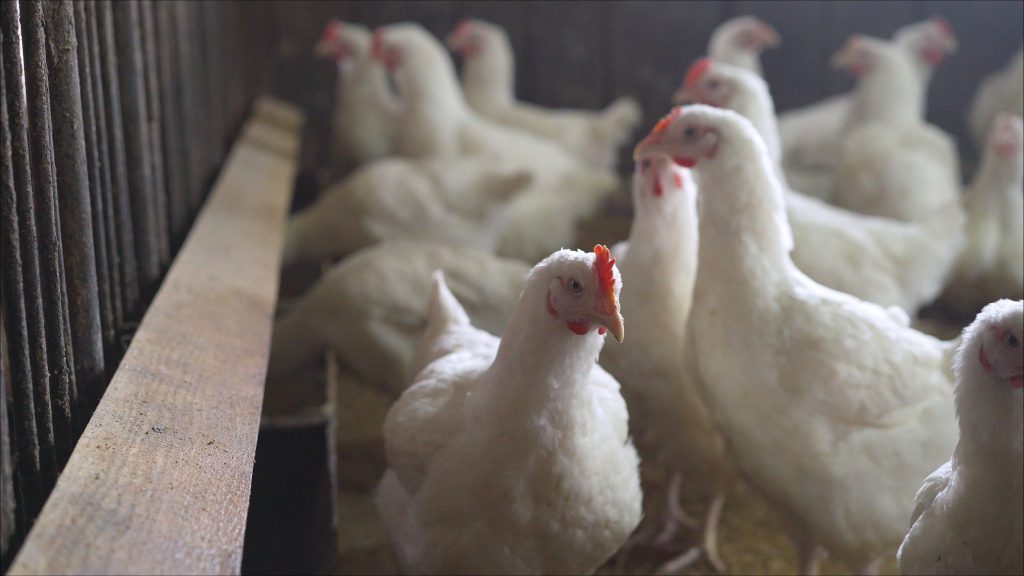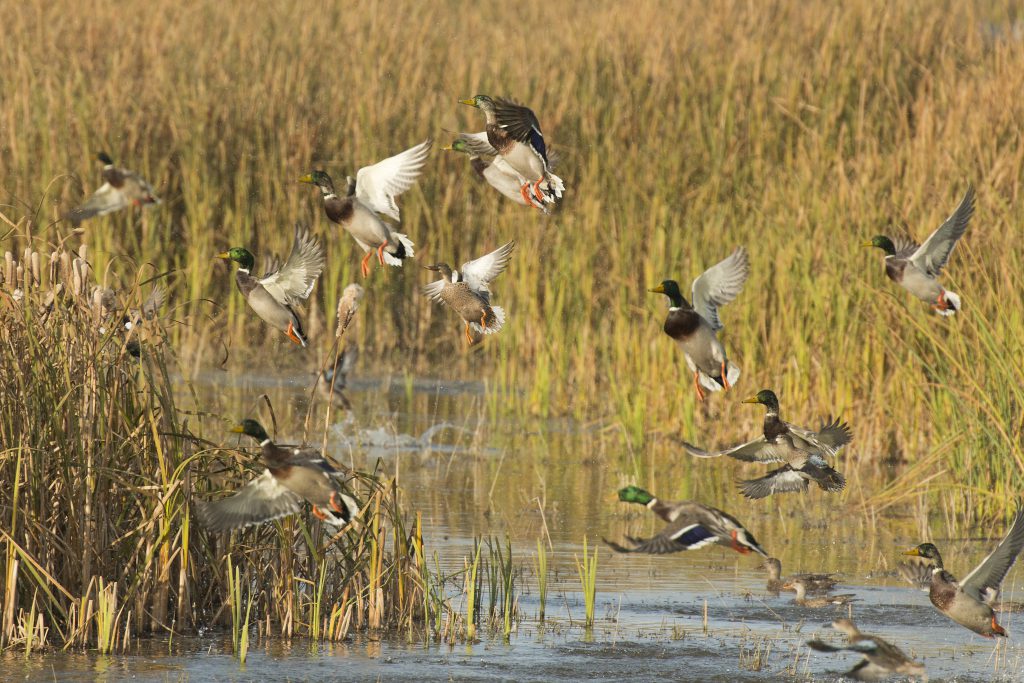Highly Pathogenic Avian Influenza (HPAI) in the Agricultural Community
Posted on by
Avian influenza (bird flu) is caused by infection with avian influenza (flu) Type A viruses. These viruses routinely spread among wild aquatic birds worldwide and can infect domestic poultry and other bird and animal species. Sporadic human infections with bird flu viruses have occurred. Avian influenza A viruses are classified into the following two categories:
- Highly pathogenic avian influenza (HPAI) virus strains are extremely infectious, often fatal to chickens, and can spread rapidly from flock-to-flock.
- Low pathogenicity avian influenza (LPAI) virus strains occur naturally in wild migratory waterfowl and shorebirds without causing illness. LPAI can infect domestic poultry, creating little or no signs of illness.
While it is rare for people to get infected with bird flu viruses, it can happen. Those who work with poultry or wild birds can be at increased risk. Infection can occur when the virus is inhaled or when a person touches something that has virus on it and then touches their mouth, eyes or nose. Some additional hazards workers can be exposed to when dealing with avian flu in their flocks include ammonia, chemical disinfectants, heat stress, dust, fatigue, and stress (see NIOSH Avian Influenza (Bird Flu) webpage). Use of personal protective equipment (PPE) should be worn when working in poultry facilities and while responding to avian influenza outbreaks.
2022–2023 Outbreaks
- The United States Department of Agriculture (USDA) reports that as of January 25, 2023, HPAI has been detected in 312 commercial flocks, 432 backyard flocks in 47 states, with over 58 million birds affected.
- HPAI has been detected in over 5,900 wild bird samples from 49 states.
- HPAI has been detected in 15 species of wild mammals (110 case reports) in geographic areas experiencing cases in domestic and wild birds.
- Outbreaks have also been reported from many countries worldwide World Organisation for Animal Health.

This blog highlights efforts to communicate risk of the virus and the related chemical and stress hazards for workers as well as prevention measures and lessons learned. These communication success stories can be applied to the current and future outbreaks.
Outbreak Response
Responding to animal and poultry disease outbreaks requires coordination and cooperation among many public and private partners. These partnerships are necessary to reduce the risk of occupational injury and illness in rural and agricultural populations by providing timely and evidence-based community guidance. Some examples of these partners include those in the Federal Government including CDC/NIOSH, USDA, OSHA and EPA; state, tribal, local, and territorial departments of public health, agriculture, and environmental health; academia including the NIOSH-funded Centers for Agricultural Safety and Health (Ag Centers); and many others including partners in industry, labor, non-profit organizations, and healthcare.
The following examples show how NIOSH/CDC guidance was translated by the U.S. Agriculture Safety and Health Centers, nonprofit organizations, and industry into information specifically for the agricultural workforce.
Ag Centers partner with non-profit organizations to share occupational resources
In April 2022, the nonprofit organization Agrisafe Network™ collaborated with several partners including the Ag Health and Safety Alliance™, the Great Plains Center for Agricultural Health (University of Iowa), Central States Center for Agricultural Safety and Health (University of Nebraska Medical Center), and the Upper Midwest Agricultural Safety and Health Center (University of Minnesota) to revise and update a document on Avian Flu: Personal Protective Equipment Guidelines.
This document serves as a resource to describe respiratory exposures and provides personal protective equipment (PPE) guidance for workers in affected poultry facilities. Created in response to a multi-state HPAI outbreak in 2014-2015, the document was revised in the spring of 2022 to assist individuals working in affected poultry facilities and areas. This resource has been instrumental for many partners assisting agricultural community members working on farm sites with USDA staff during poultry culling and composting activities.
Partnerships to address the needs of young adults working in the poultry industry
The Ag Health and Safety Alliance (AHSA) is a nonprofit organization working to educate and train young people (ages 18-25) who work with livestock (producers, agribusiness professionals, and veterinarians), including many young adult poultry producers. In the past five years, this organization has trained more than 6,000 young adults working in agriculture in the U.S. and Canada through the Gear Up for Ag Health and Safety ONLINE Program.
In May 2022, AHSA restructured their Gear Up for Ag™ programs to raise awareness about the status of the ongoing HPAI outbreak. AHSA instructors worked directly with the Upper Midwest Agricultural Safety and Health Center and the Great Plains Center for Agricultural Health utilizing their HPAI Toolkit and Avian Influenza resource page to update the AHSA guidance.
Additional examples of resources used by AHSA staff to develop up to date and engaging educational programs include:
- USDA/APHIS: USDA APHIS | Defend the Flock Program
- Minnesota Department of Agriculture HPAI ArcGIS Mapper: Minnesota Board of Animal Health (state.mn.us)
- CDC: How Infected Backyard Poultry Could Spread Bird Flu to People (cdc.gov)
- Avian-Influenza-PPE-Resource (uiowa.edu)
During Gear Up for Ag™ programs, AHSA educators also reviewed high risk tasks for HPAI such as depopulation, removal, and composting; as well as the hazards associated with cleaning and disinfecting barns. At the end of the program, young adults involved in poultry production were encouraged to share and discuss mental health and stressors related to the 2022 outbreak. Following the 2022 Gear Up for Ag™ programs, young adult participants reported that they were more likely to use PPE, purchase PPE, and engage in conversations about health and safety with their peers and family members.
Industry collaborations and partnerships
Industry organizations play a crucial role in providing guidance and recommendations to their membership for disease prevention and control. Two examples are discussed below.
In April 2022, poultry industry organizations, including the U.S. Poultry & Egg Association (USPOULTRY), National Chicken Council, National Turkey Federation, United Egg Producers, and USA Poultry & Egg Export Council collaborated with USDA on an Avian Influenza Midterm Forum. Topics covered included an epidemiological update on the current virus strain, wild bird surveillance, and the outbreak’s impact on exports. The need for enhanced biosecurity measures was also addressed.
In September 2022, USPOULTRY sponsored an Avian Influenza Lessons Learned meeting in collaboration with the National Chicken Council, National Turkey Federation, United Egg Producers, USA Poultry & Egg Export Council, and USDA. The meeting provided updates about the current HPAI outbreak with presentations from USDA representatives, state officials and industry leaders. Collaboration and the importance of biosecurity were reoccurring themes of the meeting. Presenters stressed that biosecurity practices are proven, cost effective techniques to control and prevent the spread of diseases in poultry operations. Updated biosecurity guidance for producers is available at Poultry Health & Welfare: Biosecurity.
Lessons Learned and Future Opportunities
The following lessons learned pull from this and prior outbreaks including the U.S. HPAI in 2014-2015 and COVID-19.
- Simple messages are the most effective
Local education programs and trainings highlighting evidence-based information will continue to be instrumental for raising community awareness and reducing the spread of transmission of HPAI in the agricultural industry. While modifying the Gear Up for Ag™ program to highlight HPAI response, AHSA educators found that young adults in agriculture were more likely to remember very simple messages that could be quickly adopted on their family farms immediately.
- Shifting beliefs on importance of farm biosecurity will reduce future outbreaks
Many organizations have done a lot of work to raise awareness of good biosecurity practices on all livestock operations to aid in preventing future disease outbreaks. In 2020, AHSA worked with the Upper Midwest Agricultural Safety and Health Center to include more biosecurity curriculum in the Gear Up for Ag™ program for both small and large farms to reduce overall spread of zoonotic disease.
- Include other workforce groups in HPAI outbreak response
Outreach and communication professionals should include more workforce groups such as veterinarians, academic professionals, cooperative extension personnel, youth workers, farmworkers, and even community members—particularly those who are in areas of the U.S. with extensive poultry production. It is important to listen to these unique groups and their needs in addressing outbreak response. Lessons were learned during the 2015 outbreak, when local producers were assisting USDA workers in depopulation and composting tasks but did not have the adequate PPE.
- Access to proper-fitting PPE and training can be challenging
As seen during prior HPAI outbreaks and the COVID-19 pandemic, PPE shortages make it extremely difficult for workers involved in agricultural production to obtain the protection that they need for dangerous tasks such as handling pesticides and chemicals and responding to disease outbreaks. This can be especially challenging for small farms. It can also be difficult to obtain correctly sized PPE for those who require smaller-sized PPE and respirators. There is also a need for more guidance on PPE stocking and storage. In addition, it is important to build the local community’s capacity to better respond to outbreaks and provide useful local services, such as selling the proper safety equipment to responders and livestock producers. Additionally, health departments and other qualified organizations should be ready to provide respirator fit testing and PPE training when necessary.
- Communication
Successful outbreak response requires continuous communication with everyone involved in the response. Communication is especially important as staff rotate in and out of the response for continuity and consistent messaging on safety procedures, depopulation, sanitation, and repopulation, and worker symptom monitoring.
Future Research and Response Needs
In addition to the future opportunities and needs mentioned above, please share your ideas with us. What ideas do you have for better integrating efforts for this ongoing HPAI outbreak and future disease outbreaks and emergency response? What are gaps in your preparedness plans and how can these be addressed? We look forward to hearing your ideas.
Carolyn Sheridan, RN, BSN, Executive Director and Founder of Ag Health and Safety Alliance™
Jenna Gibbs, MPH, PhD, is Director of Operations of Ag Health and Safety Alliance™
Matthew Spencer, CSP, SHRM-CP, Director of HR & Safety Programs, U.S. Poultry and Egg Association
John Gibbins, DVM, MPH, Senior Veterinary Advisor, NIOSH Office of Agriculture Safety and Health
Additional references and resources
- Avian Influenza (Bird Flu) | NIOSH | CDC
- Information on Bird Flu | Avian Influenza (Flu) (cdc.gov)
- Who Needs a Flu Vaccine | CDC
- USDA APHIS | 2022 Confirmations of Highly Pathogenic Avian Influenza in Commercial and Backyard Flocks
- Avian Influenza information | Great Plains Center for Agricultural Health (uiowa.edu)
- Avian Influenza – AgriSafe Network
- Poultry Health & Welfare: Biosecurity (www.uspoultry.org)
- Implement Preventative Measures Against Avian Influenza Now! by USPOULTRY Podcast (anchor.fm)
Posted on by

